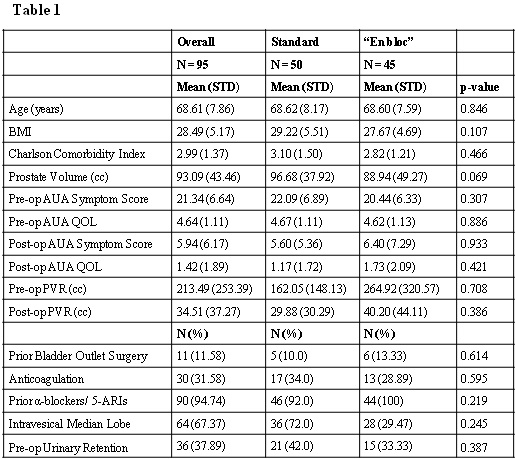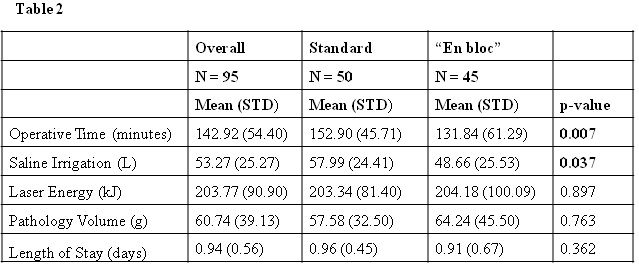"En Bloc" with Early Apical Release Compared to Standard Holmium Laser Enucleation of the Prostate During Initial Learning Curve
Benjamin Press, MD, Eric Ghiraldi, DO, Hari Nair, BS, Katelyn Johnson, MD, Daniel Kellner, MD.
Yale University School of Medicine, New Haven, CT, USA.
BACKGROUND: Holmium laser enucleation of the prostate (HoLEP) has emerged as an alternative treatment to transurethral resection of the prostate for bladder outlet obstruction. Widespread adaptation has been limited by the steep learning curve necessary to master HoLEP. We sought to compare operative efficiency of HoLEP using both the standard, multi-incisional approach and “en bloc” with early apical release (EBAR) during the initial learning curve.
METHODS: We retrospectively reviewed the initial 95 consecutive men who underwent HoLEP between April 2019 and September 2020 by a single surgeon. 50 patients underwent standard HoLEP procedure, and 45 patients underwent EBAR. We compared patient demographics, pre and post-operative metrics, (Table 1) as well as intra-operative metrics (Table 2) between both groups. Differences between groups were evaluated with Mann-Whitney U and Kruskal-Wallis tests.
RESULTS: There were no statistically significant differences between groups among the variables listed in Table 1. Compared to a standard HoLEP, EBAR was associated with lower volume of saline irrigation used (48.66 L vs. 57.99 L, p = 0.037) and decreased operative time (131.84 minutes vs. 152.90 minutes, p = 0.007) (Table 2), even with similar weight of tissue removed. There was no difference in length of stay (0.91 days vs. 0.96 days, p = 0.362) or in laser energy used (204.19 kJ vs. 203.34, kJ, p = 0.897). There were no differences in Clavien ≥ 2 complications between the groups.
CONCLUSIONS: The utilization of the EBAR technique during the initial learning curve allows for a faster, more efficient operation without any difference in functional outcomes or major complications compared to a standard HoLEP. 

Back to 2021 Abstracts
